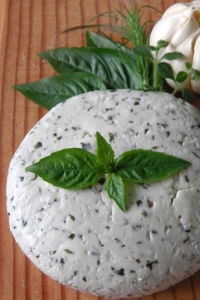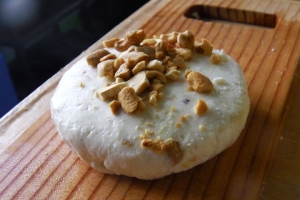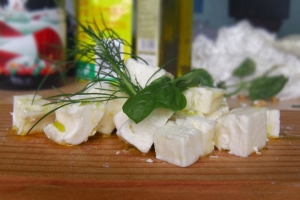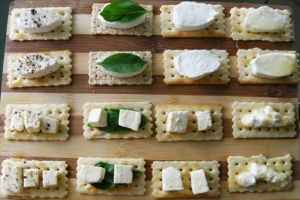A Cheesy Story
Xilca Alvarez
 It all started as a joke.
It all started as a joke.
I was grappling with a premature midlife crisis, and attended an inspiring Gawad Kalinga (GK) Center for Social Innovation forum in Ateneo de Manila University sometime in October 2010, in the desperate hopes of finding some business students/professors to create a sustainable livelihood program for ex-cons (probationers, to be more specific—a pet advocacy of mine[1]). Instead, I was instantly enthralled by the idea of this mystical GK Enchanted Farm, which they were developing as a "village university and silicon valley for social enterprises," and a "social tourism site" where bed and breakfasts would rise, and tourists would flock to be served the best produce and experience an inclusive and thriving GK community; one that would also encourage reverse migration with the promise of sustainable livelihood and would serve as a catalyst for countryside development. So curious was I that I found myself going to this "enchanted" farm in Angat, Bulacan the very next day with some GK officers.
When I first got there, the infrastructure was no more than the 2 hectares of GK homes, an unfinished multi-purpose hall, plans for making an industrial kitchen, some plants and crops, a piggery, acres of idle land with wild grass or lots and lots of talahib, so you needed a lot of imagination to see what could rise here and there.
I cheerfully recounted a visit to a winery with a goat dairy (much, I would imagine, like Napa Valley) while on vacation in South Africa earlier that year. Recalling the quality of the goat cheeses, I "kid-dingly" suggested that Gawad Kalinga emulate this as an agri-business for their beneficiaries. "We can even call it GK," I teased, "short forGawad Kambingan!" "And all the products can be called GK, too", I added, "like Goat Keso, Gatas ng Kambing, Gourmet Kaldereta!"
But what was meant as nothing more than a joke eventually returned to me as a serious proposition.
 A month later, when I informally met the GK founder, Tony Meloto, he actually said, "that's a great idea. And YOU should be the one to do this!" He then gave me a copy of his book, which I voraciously read, and, being the impressionable person that I am, this time I was not only inspired, but also became rather determined. That, and I'm almost certain I was hypnotized, which is how I came to be brainwashed into buying the whole vision-mission.
A month later, when I informally met the GK founder, Tony Meloto, he actually said, "that's a great idea. And YOU should be the one to do this!" He then gave me a copy of his book, which I voraciously read, and, being the impressionable person that I am, this time I was not only inspired, but also became rather determined. That, and I'm almost certain I was hypnotized, which is how I came to be brainwashed into buying the whole vision-mission.
Stunned to find myself suddenly faced with a daunting new task, I began the real work sometime in February 2011, which included, among others, buying and literally transporting a few dairy goats to the Enchanted Farm, all clad in diapers and who just wouldn't stop "mehhh-ing" (and, worse, pooping) from Batangas to Bulacan (to do this, I borrowed a van whose owner had absolutely no clue I was chauffeuring for goats; thankfully, to this day, my dad doesn't know how to browse through the Net). These goats included 2 kids, an exceptionally adorable one we called Gwaping Kambing (nicknamed "Ping"), and his less attractive and more ordinary (but still cute) brother, Generic Kambing (nicknamed "Eric").
 Having no previous experience in cheesemaking, I researched and taught myself relentlessly even as critics in the dairy industry told me that it takes years to learn to do the craft right. Yet, much to my own surprise (and after lots of trial and error, and I mean lots[2]), it wasn't long before we began producing cheeses to the satisfaction of local gourmands. Encouraged by these results, we even organized a network of subsistence karabao farmers in the surrounding community in Bulacan (hence, the demise of the fanciful name Gawad Kambingan, as it evolved into Goats and Karabaos) to expand our product line[3]and to create more social impact, and, together with the GK community in the Enchanted Farm (which has since been developed tremendously from when I first visited, complete with the necessary facilities for processing), began making products that they could proudly call their very own gourmet keso.[4]
Having no previous experience in cheesemaking, I researched and taught myself relentlessly even as critics in the dairy industry told me that it takes years to learn to do the craft right. Yet, much to my own surprise (and after lots of trial and error, and I mean lots[2]), it wasn't long before we began producing cheeses to the satisfaction of local gourmands. Encouraged by these results, we even organized a network of subsistence karabao farmers in the surrounding community in Bulacan (hence, the demise of the fanciful name Gawad Kambingan, as it evolved into Goats and Karabaos) to expand our product line[3]and to create more social impact, and, together with the GK community in the Enchanted Farm (which has since been developed tremendously from when I first visited, complete with the necessary facilities for processing), began making products that they could proudly call their very own gourmet keso.[4]
Five months later, a batch of French students who had volunteered to do humanitarian work and intern for social enterprises at the Farm were just too pleasantly surprised to find out the GK community makes cheese. And not just any cheese, but pretty darn good cheese. These French interns were so thrilled that they graciously volunteered to be the salespeople for local cheese (pretty ironic indeed) in the weekend market. And the technological imbecile that I am will be forever grateful to these crazy guys[5] for this website they excitedly put up for Gourmet Keso, what they affectionately call "the French-approved cheese".
Through hard work and the perseverance of the GK community, we've proven the doubters wrong and, hopefully, will steadily win over customers and prove that the community and the Pinoy can make ridiculously good products, probably even better than imported ones.
Truth be told, I really get a kick out of it whenever some passerby at a bazaar, after tasting the cheese, asks where it's imported from or where it's made, and I get to floor them when I say it's proudly produced by Gawad Kalinga residents in Enchanted Farm, Angat, Bulacan.
The look of disbelief never fails. "Wow, really?!"
Yup.
No kidding.
It may have started as a joke, but now we're serious about making seriously good cheese.
Xilca September 11, 2011
Patience—in time, the grass...becomes cheese.
It's gonna be legend … wait for it ... dairy.

For orders, questions and other inquiries, you can get in touch with Xilca through the following:
Email: gourmet.keso@gmail.com
Contact No: 09178194522



